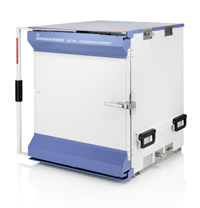DST200 RF Diagnostic Chamber

RF diagnostic chamber from Rohde & Schwarz provides free-space conditions on the lab workbench
Munich, July 20, 2010 — The compact R&S DST200 RF diagnostic chamber makes it easy for developers of wireless devices such as mobile phones to perform reproducible radiated RF measurements on the workbench. The benchtop chamber simulates conditions that approximate free space and features a 700 MHz to 6 GHz broadband test antenna especially designed for the chamber. Users can measure self-interference (desense) or radiated emissions, perform coexistence tests and verify the antenna radiation pattern during development. As a result, designers do not have to wait for test times to become available in large EMC test chambers.
Today's smart phones integrate complex technologies into the smallest possible space. Unfortunately, this spatial proximity leads to self-interference caused, for example, by WLAN and Bluetooth® modules as well as by cameras, displays or oscillators. Interference can reduce receiver sensitivity, which in turn can result in the disruption or disconnection of calls near the edge of a radio cell. The new R&S DST200 RF diagnostic chamber allows developers of smart phones to test and optimize their designs early in the development phase to reduce self-interference to the optimal levels.
Due to the RF diagnostic chamber's compact size of 770 mm x 760 mm x 695 mm (W x H x D), it can be placed on the workbench in the lab. Since the developer can test new devices repeatedly in the design phase with minimal effort, the progress of the project no longer depends on the assigned test times in large EMC test chambers, which are usually booked long in advance. Only the final certification measurement must be performed in a large test chamber, where it is highly likely that the device will achieve a first-time pass. The compact R&S DST200 RF diagnostic chamber enables an R&D department to operate more flexibly and use test tools and test environments more efficiently than ever before.
The R&S DST200 has a circularly polarized, 700 MHz to 6 GHz test antenna at the top of the actual test chamber. The high field uniformity that the chamber produces throughout the equipment under test's entire volume ensures excellent reproducibility of results. Results remain stable even if the EUT is slightly shifted. If conventional shielded chambers that depend on antennas couplers were used instead, results would change significantly. The shielding effectiveness of the chamber exceeds 110 dB, allowing sensitivity tests on GPS receivers with input levels of below –160 dBm. To achieve these shielding properties, Rohde & Schwarz developed a new locking mechanism for the door. This mechanism, for which a patent is pending, achieves high shielding effectiveness with low locking forces and also protects the RF gaskets.
In addition, a 3D positioner is optionally available. It allows the user to move the EUT to any defined position relative to the test antenna and fix it in place with a turn of the wrist. The 3D positioner features two axes of rotation with angular scaling. Due to its open structure, the EUT's keypad, for example, is directly accessible.
Another special feature of the R&S DST200 is the inclusion of shielded compartments above and below the test chamber. They provide space for additional hardware such as preamplifiers, RF filters or RF feedthroughs. Users can adjust the test setup to their individual requirements without impairing the field uniformity of the chamber.
The R&S DST200 RF diagnostic chamber is now available from Rohde & Schwarz.
